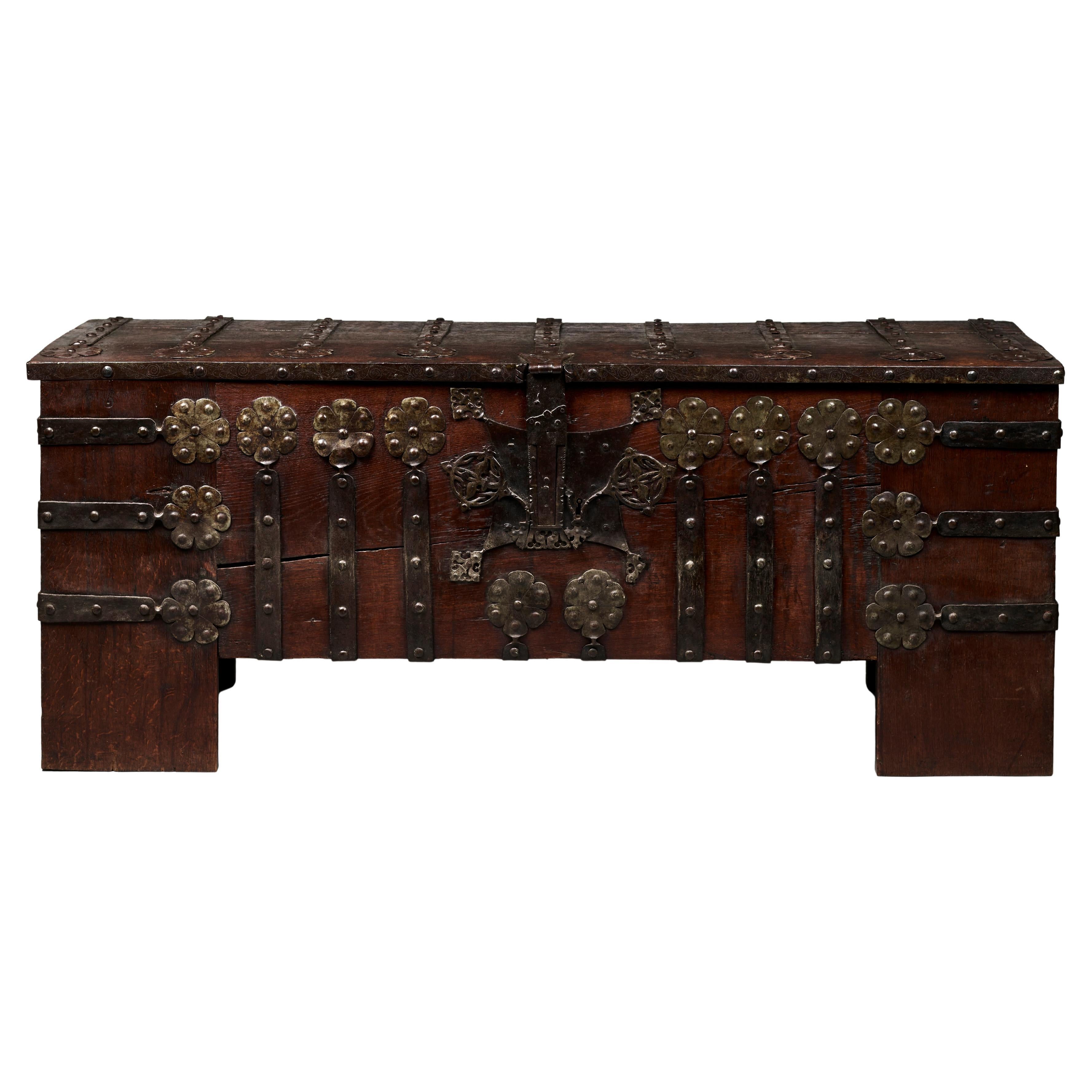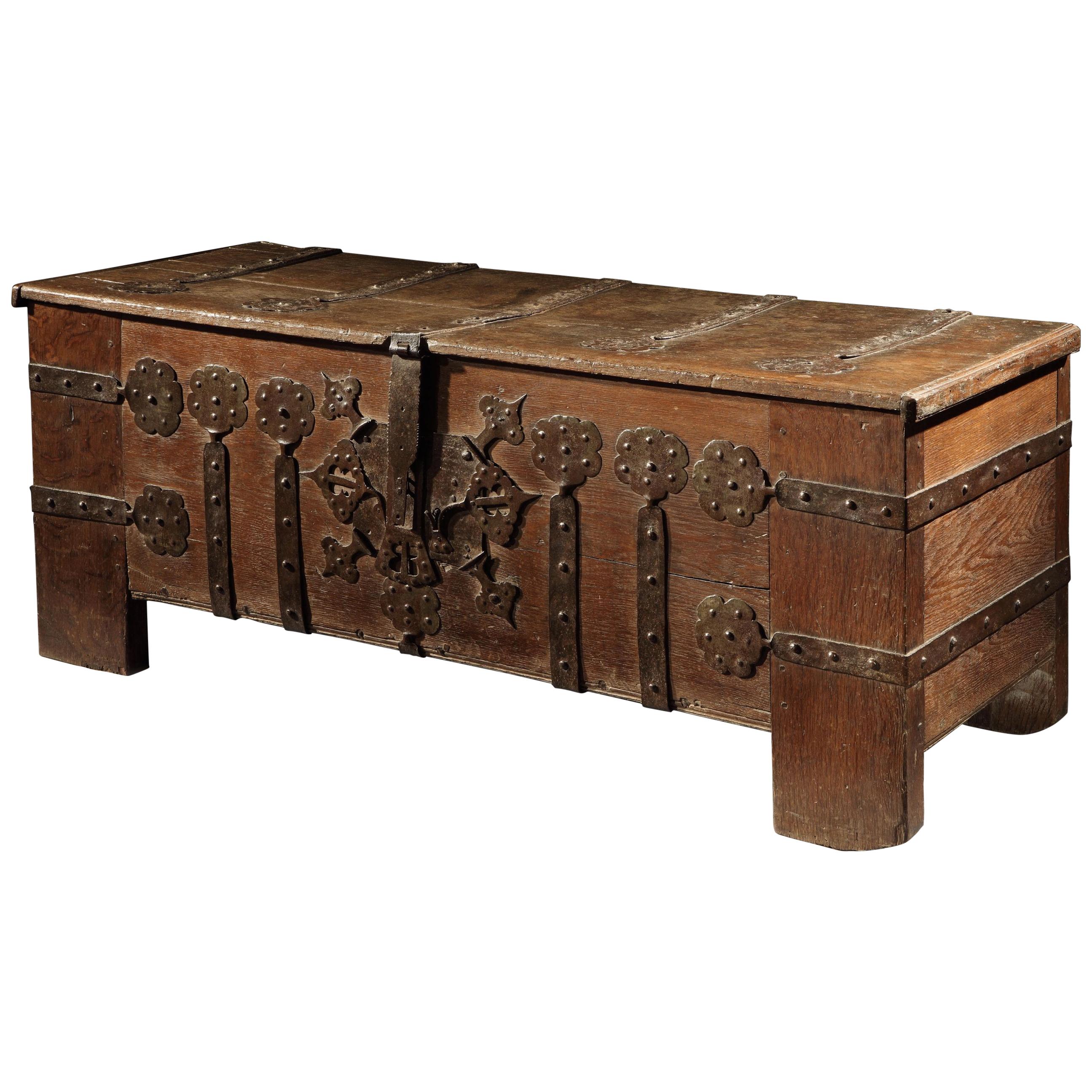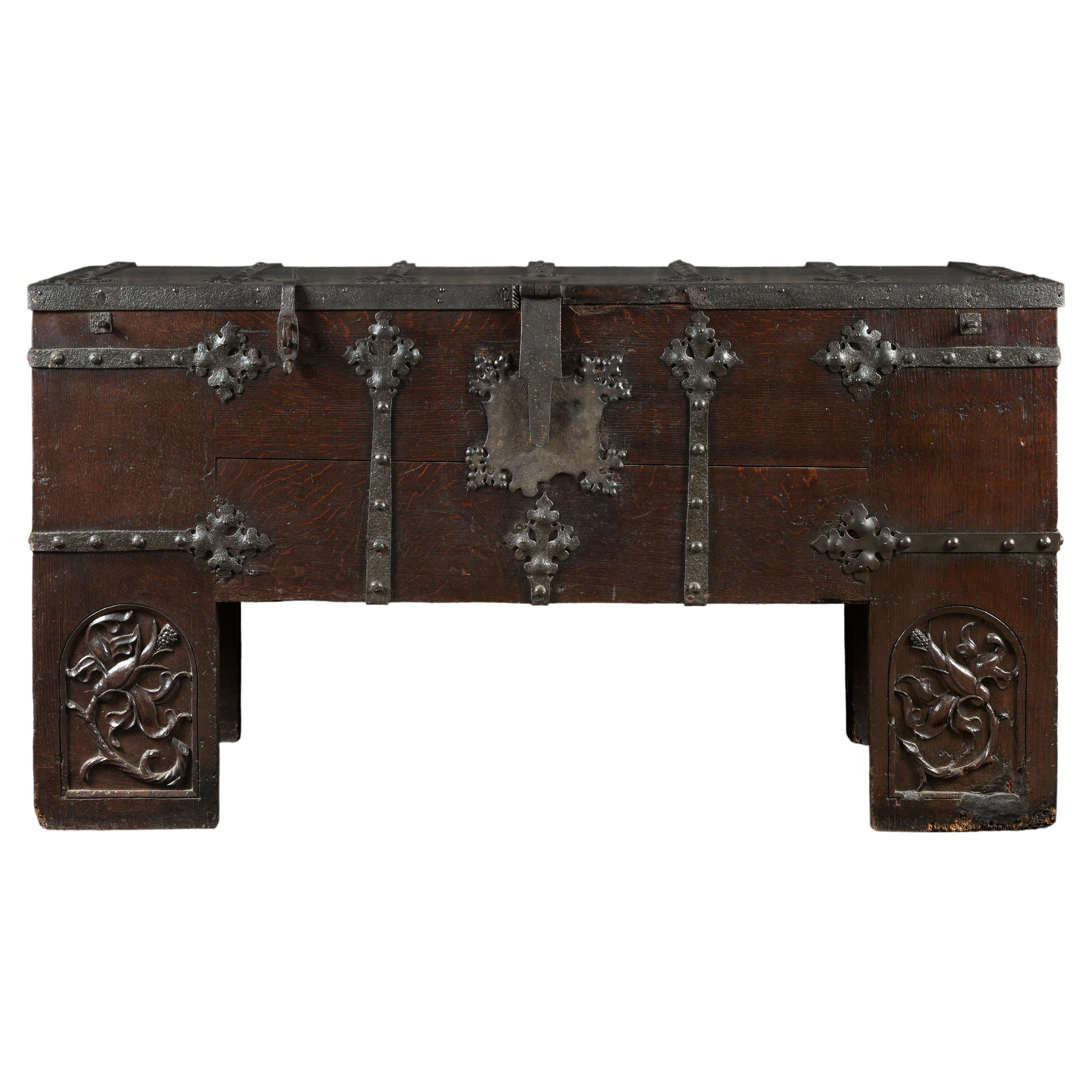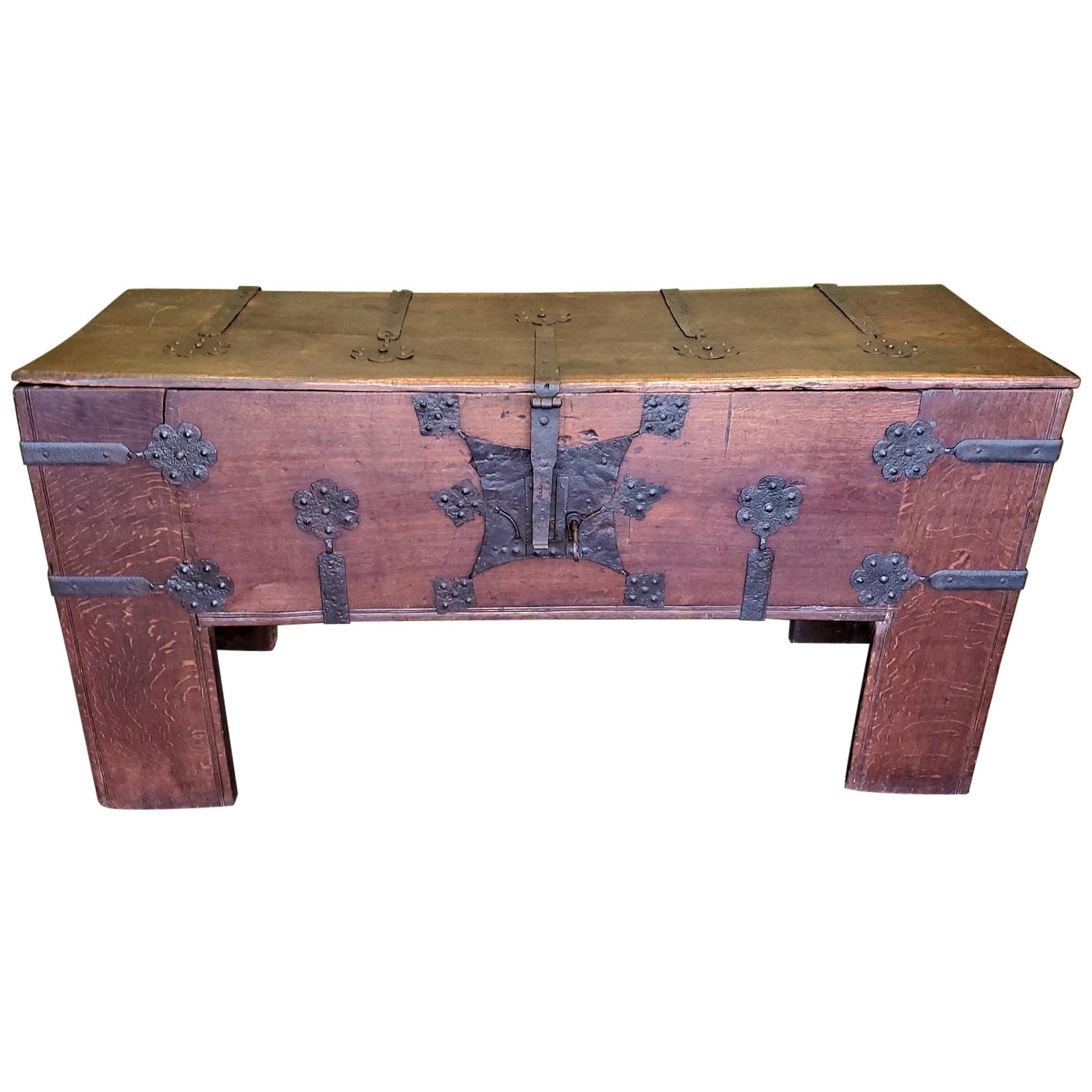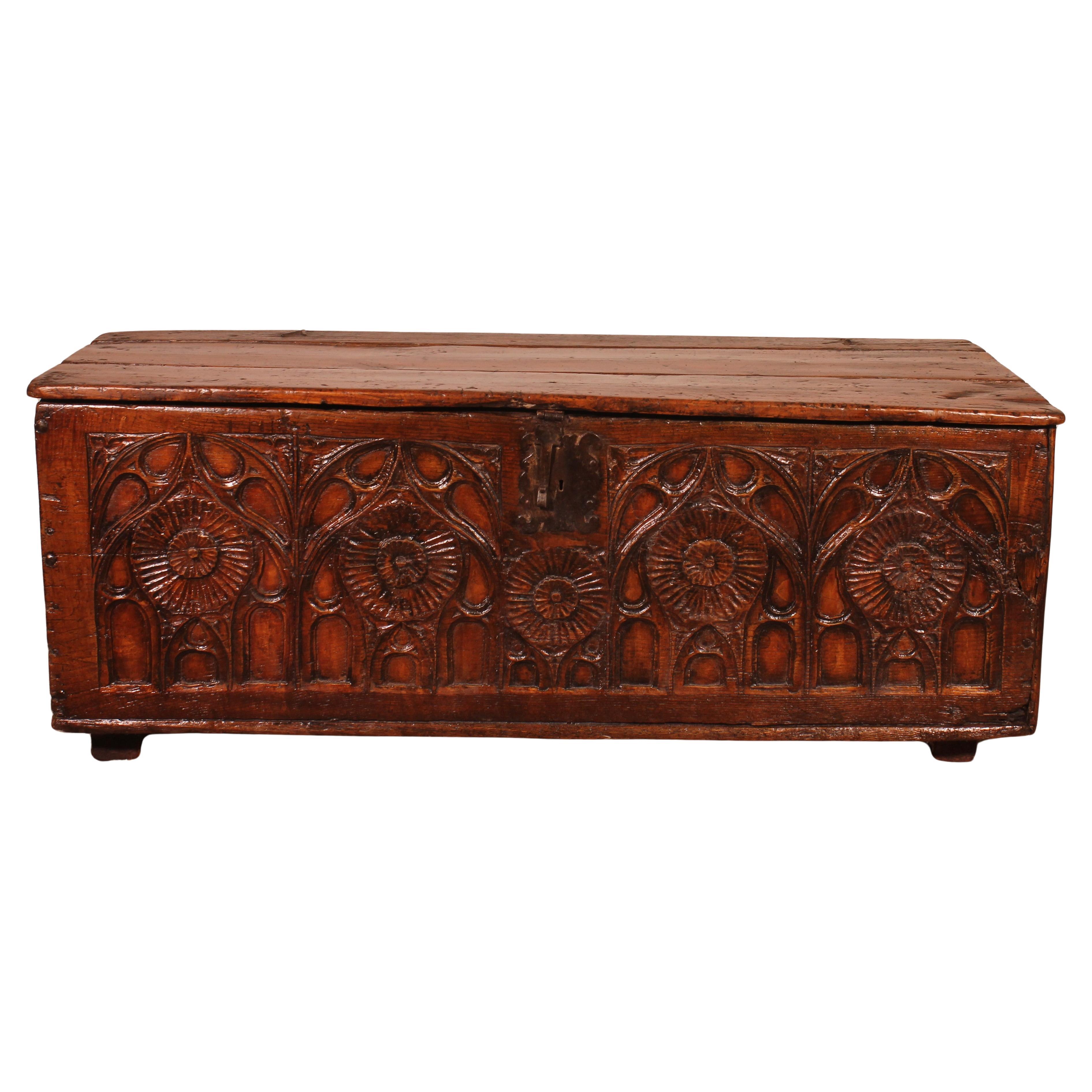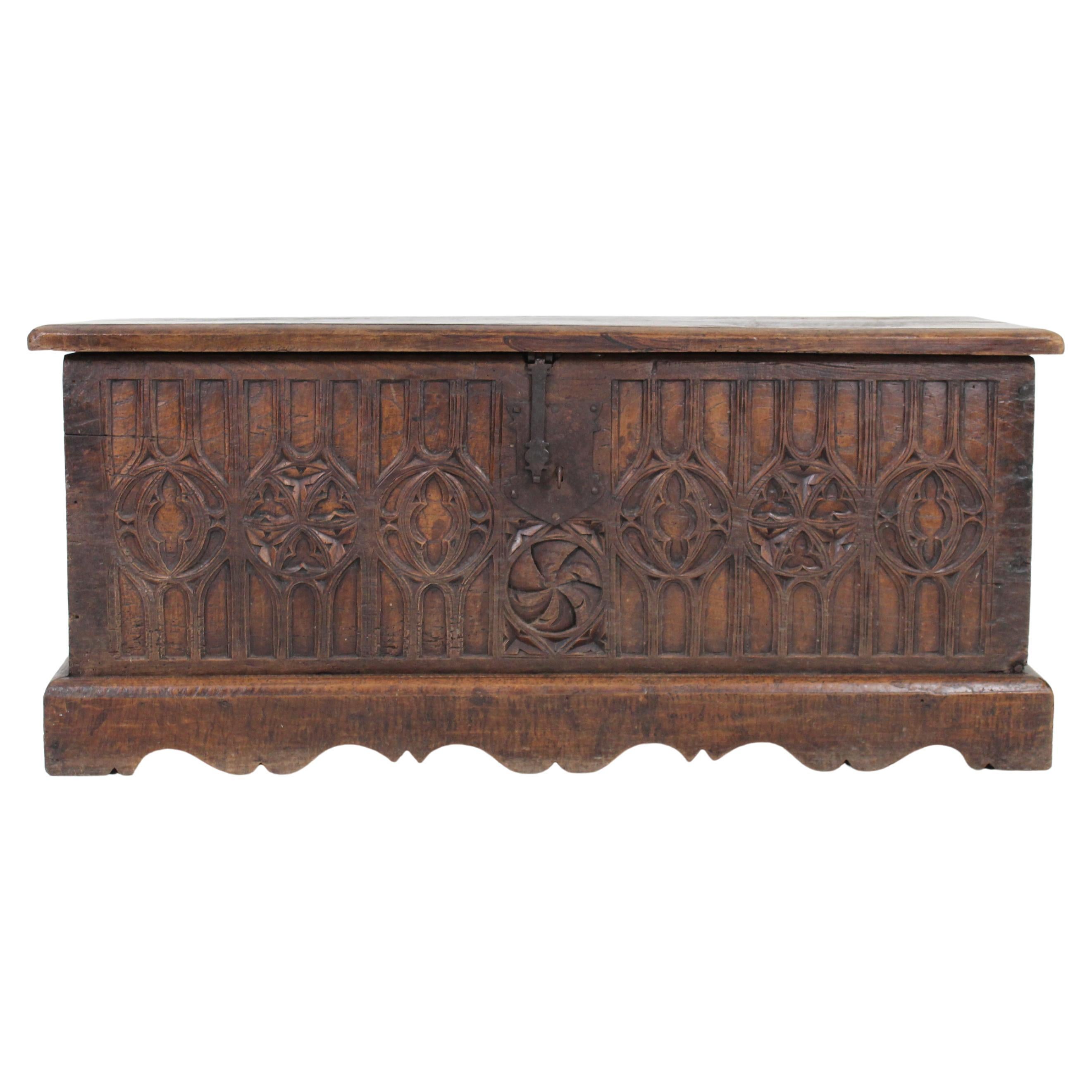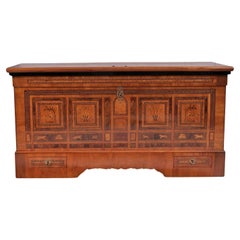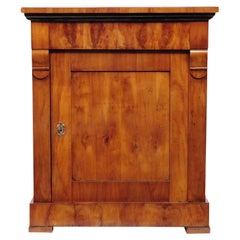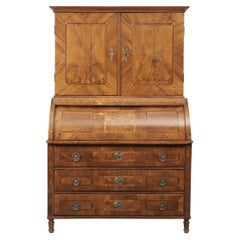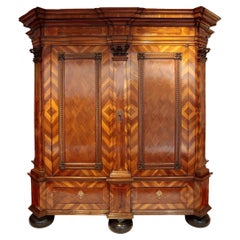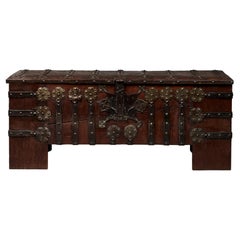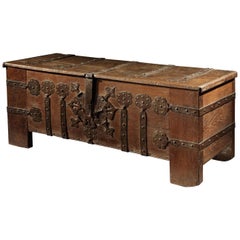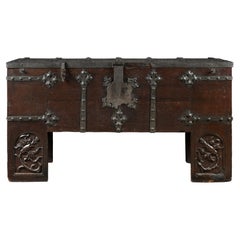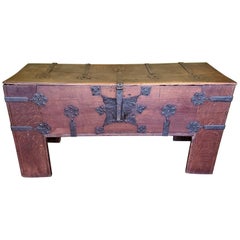Items Similar to Gothic front gallery chest, Westphalia around 1500 - 1550, oak
Want more images or videos?
Request additional images or videos from the seller
1 of 21
Gothic front gallery chest, Westphalia around 1500 - 1550, oak
$15,733.36
$19,666.7120% Off
£11,650.04
£14,562.5520% Off
€13,200
€16,50020% Off
CA$21,635.74
CA$27,044.6720% Off
A$24,061.03
A$30,076.2920% Off
CHF 12,594.84
CHF 15,743.5520% Off
MX$293,515.36
MX$366,894.2020% Off
NOK 158,258.77
NOK 197,823.4620% Off
SEK 148,862.80
SEK 186,078.5120% Off
DKK 100,500.01
DKK 125,625.0220% Off
About the Item
Gothic front gallery chest, Westphalia around 1500 - 1550, wrought iron bands, boxy oak body, partially carved. Monumental star-shaped key plate with original key, feet on the front with carved coat of arms rosettes
Dimensions: height 73 cm, width 146 cm, depth 63 cm
The lid plate was previously remounted, position of the remounted hinges therefore visible, see photos.
Frontal chests (also known as “Stollentruhen” ) are Gothic chests that rest on posts (Old High German: stollo). The construction, which dates back to the 12th century, consists of four upright planks to which the cross planks of the long and side walls are attached.
A large number of frontal chests have been preserved in northwest German nunneries. They were brought by the novices and contained their personal possessions. So-called chest corridors still exist in the Wienhausen and Lüne convents.
The carved coats of arms on the chest probably belong to the von Lilien and von Papen families, salters (Erbsälzer) in Werl in Westphalia.
The first documented mention of the Erbsälzer dates back to 1246, when Archbishop Conrad of Cologne confirmed the special privileges of the Werl Sälzer. Over the centuries, a total of around 44 families were members of the Erbsälzer, families who inherited the right to boil salt.
- Dimensions:Height: 28.75 in (73 cm)Width: 57.49 in (146 cm)Depth: 24.81 in (63 cm)
- Style:Gothic (Of the Period)
- Materials and Techniques:
- Place of Origin:
- Period:
- Date of Manufacture:1500-1550
- Condition:Wear consistent with age and use.
- Seller Location:Münster, DE
- Reference Number:1stDibs: LU9172241933612
About the Seller
5.0
Recognized Seller
These prestigious sellers are industry leaders and represent the highest echelon for item quality and design.
Established in 2000
1stDibs seller since 2023
5 sales on 1stDibs
- ShippingRetrieving quote...Shipping from: Münster, Germany
- Return Policy
Authenticity Guarantee
In the unlikely event there’s an issue with an item’s authenticity, contact us within 1 year for a full refund. DetailsMoney-Back Guarantee
If your item is not as described, is damaged in transit, or does not arrive, contact us within 7 days for a full refund. Details24-Hour Cancellation
You have a 24-hour grace period in which to reconsider your purchase, with no questions asked.Vetted Professional Sellers
Our world-class sellers must adhere to strict standards for service and quality, maintaining the integrity of our listings.Price-Match Guarantee
If you find that a seller listed the same item for a lower price elsewhere, we’ll match it.Trusted Global Delivery
Our best-in-class carrier network provides specialized shipping options worldwide, including custom delivery.More From This Seller
View AllMarburg finch chest Biedermeier around 1800-10 Cherrywood bridal chest
Located in Münster, DE
Marburg finch chest
Biedermeier around 1800/10, cherry wood and other precious woods richly veneered and marquetry on an oak body, hunting motif, 2 small drawers in the base area, or...
Category
Antique Early 1800s German Biedermeier Commodes and Chests of Drawers
Materials
Cherry, Fruitwood, Oak
$5,214 Sale Price
30% Off
19th Century Half cabinet, Biedermeier, Rhineland, around 1815/20 cherrywood
Located in Münster, DE
Half cupboard
Biedermeier, Rhineland around 1815/20, cherry veneered on softwood, concealed drawer, ebonized profile,
shellac hand polish
Dimensions: height 77 cm; width 64 cm; dep...
Category
Antique Early 19th Century German Biedermeier Commodes and Chests of Dra...
Materials
Cherry, Fruitwood
Top cabinet secretary, Baden, around 1780/90 Walnut and walnut burl
Located in Münster, DE
Secretary à deux corps
Top cabinet Baden, around 1780/90
Walnut and walnut burl veneered and marquetry,
3-tier chest of drawers, cylinder lock with automatic pull-out mechanism, o...
Category
Antique 1780s German Empire Secretaires
Materials
Wood, Nutwood
$15,065 Sale Price
20% Off
Baroque Hall Cupboard Westphalia 1775/80 Walnut and Plum
Located in Münster, DE
Hall cabinet from the Budde Warendorf cabinetmakers, Westphalia, around 1770, walnut and plum veneered on oak, elaborate geometric veneer pattern, banded decoration, prismatic body...
Category
Antique 1780s German Baroque Cupboards
Materials
Ebony, Fruitwood, Oak
Chest of drawers, Louis Seize around 1790
Located in Münster, DE
Louis Seize chest of drawers, circa 1790
Walnut and plum veneered on a softwood body, band inlays, the edges inlaid all around with maple and ebony, three drawers, original fittings...
Category
Antique Late 18th Century French Empire Commodes and Chests of Drawers
Materials
Wood, Nutwood
Baroque Hall Cupboard 1770/80 Walnut and Walnut Burl
Located in Münster, DE
Important hall cabinet from around 1770/1780
Walnut, walnut burl and other precious woods veneered on softwood, two-door body divided by three pilasters, doors with octagonal carto...
Category
Antique 1780s German Baroque Cupboards
Materials
Oak, Walnut, Burl
You May Also Like
Rare Gothic German Oak and Iron Chest Known as "Stollentruhe" 16th century
Located in Worpswede / Bremen, DE
The large rectangular standing chest on stile feet, extensively mounted with wrought ironwork straps with stylised sixfoil motif. These are fixed with convex head nails: running vert...
Category
Antique 16th Century German Gothic Blanket Chests
Materials
Iron
Chest or Stollentruhe, Early 16th Century, German Gothic, Oak Chest, Original
Located in BUNGAY, SUFFOLK
This standing chest is of clamp-front construction, extensively decorated with long, ironwork straps with quatrefoil finials which ‘wrap’ around it, and has an ornate, central lockplate, and front legs with full, height stiles. The ironwork straps and finials are fixed with convex, headed nails: running along the front, five long straps; the two side straps; and the five straps on the top. On the chest front, centrally placed, is a large, iron lockplate with four outer, radiating spade finals in each corner and three, superimposed spade finials (a symbol of nobility) which are pierced with the initials ‘BB’. The lockplate receives a corresponding, external hasp fitted to the lid. Below the floor of the chest, the two front stile legs retain most of their original height. The lid is supported by substantial iron strap hinges that extend right down the back of the chest. Inside the chest at the left end is a shallow, oak till.
Construction The chest is of joined, 'clamp-front' construction, reinforced by the nailed, iron mounts. In total it uses ten, oak boards which were riven and planed. The back and front are each formed from a large single plank held to the full height stiles by long, pegged tenons. The sides are also single boards joined into the stiles using long tenons held by dowels, and extend down below the chest bottom, concealing the ends of the bottom boards. The bottom consists of a single board cut into the sides and shallow rebates in the stiles. The front and back boards are dowelled into the bottom boards. The lid which overhangs the sides has a narrow cleat at each end, and consists of one wide plank which has bowed a little as a result of shrinkage.
Ironwork : The wrought ironwork straps, lockplate, hasp and lock all appear all appear to be early, and of the same original manufacture and are fixed with convex headed nails. There is mild dark staining of the oak around the iron mounts, possibly because of low tannin content in the oak.
Length 172 cm., 67 ¾ in., Height 71.5 cm., 28 ¼ in., Depth 63 cm., 24 ¾ in.,
Related to: No 900:2-1904 V&A Museum, London. Stadtmuseum Dusseldorf. Decorative Arts Museum Berlin. Museen Schleswig-Holstein & Hamburg. A related example featuring elaborately-carved feet and formerly in the Horsham Museum, West Sussex, sold at Christie's in 2010 for £97,250 and another example, again with carved feet sold at Sothebys in 2006 for £48,000.
Literature: A similar example is illustrated in H. Lüttgens, Alt- Aachener Wohnkultur; Ein Rundgang durch ein altes Aachener Haus im Wohnstil des 18. Jahrhunderts, Aachen, n.d., ill. 12, and another comparable iron-bound chests...
Category
Antique 16th Century German Gothic Blanket Chests
Materials
Oak
Rare Gothic German Oak and Iron Chest Known as "Stollentruhe"
Located in Saint-Ouen, FR
This large chest stands on high legs prolonging the lateral jambs. Presenting a sober and severe appearance the chest still belongs to the Medieval tradition. The piece is made from very high quality Hungarian wood.
The jambs are joined to the facade and the lateral sides thanks to pegged mortise and tenon securing a great stability and squareness between each parts. The upper lid is made of two joined parts and so is the facade.
The ironwork is present all over the surface of the chest and brings both an additional stability to the construction as well as a rich decor. The lid is secured with hinges. Hinges also run all over the chest in horizontal and vertical lines, ending in a floral motif. The hasp lock is also very ornamental.
Those chests always present important proportions especially when they are made early in the period. This model was very popular in Germany and stayed in vogue until the 16th century. However the feet Gothic decor...
Category
Antique 15th Century and Earlier German Gothic Blanket Chests
Materials
Wrought Iron
Rare (Late Medieval) 16th Century German Wrought Iron Oak Chest or Stollentruhe
Located in Dallas, TX
WE HAVE THE PLEASURE TO PRESENT an Exceptionally Rare (Late Medieval) 16th Century German Wrought Iron Oak Chest or Stollentruhe.
This is an Early...
Category
Antique 16th Century German Gothic Blanket Chests
Materials
Wrought Iron
Gothic Period Oak Chest 15 Century
Located in Brussels, Brussels
exceptional late 15th century/early 16th century carved oak Gothic period chest from Northern of France.
Very fine example of a flamboyant Gothic style chest with a superb carved f...
Category
Antique 15th Century and Earlier French Gothic Blanket Chests
Materials
Oak
Gothic chest with decorated front late 18th century
Located in Diest, BE
An antique Gothic French chest with a carved wood exterior and metal hardware.
Category
Antique 18th Century French Gothic Blanket Chests
Materials
Wood
$1,391 Sale Price
35% Off
More Ways To Browse
1500 Furniture
Iron Bands
Antique German Chests
Gothic Cross
Gothic Oak Cabinet
Document Chest
16th Century Cross
Plank Chest
Gothic German
Hand Carved German Cabinet
Large Iron Crosses
Old Antique Blanket Chest
Antique Post Office Cabinet
16th Century Oak Chest
Studded Chest
18th Century Carved Blanket Chest
Wedding Blanket
Hope Chest
